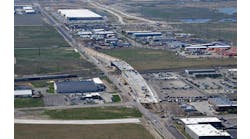By Mark DeVries, Contributing Author
Now that it’s February, road authorities across the country might want to take a step back and think about how winter maintenance has gone so far this winter.
During November, December, and January, it may have been challenging for these officials to get timely and accurate information to keep roads clear and safe. They deal with increased road usage, limited budgets, increased driver expectations, and the escalation of extreme weather events.
As many of you know, snowy roads and icy conditions can make any journey more difficult. However, according to the National Highway Traffic Safety Administration 17% of all vehicle crashes occur in the face of winter conditions.
And, icy roads kill more than twice as many people as tornadoes, hurricanes, lightning and severe thunderstorms combined, according to icyroadsafety.com. At the same time, freezing weather can lead to cracks and the formation of potholes on roads and other surfaces.
Given that the Federal Highway Administration reports that 70% of the U.S. population lives in areas impacted by ice and snow production, decision-makers need to constantly assess how they maintain winter roads.
They also should understand the conditions of the roads and the environmental conditions impacting roadways to perform maintenance operations that reduce risks posed by hazardous driving conditions. Monitoring the current conditions on roadways nearby and in remote locations is critical to effective winter maintenance operations, and many road authorities are beginning to utilize new high-tech solutions to help examine roadways and minimize the impact of winter weather on our roads.
Winter road maintenance has evolved to improve efficiencies and maintenance outcomes. However, some of these changes are also driven by environmental issues that agencies may overlook, including the overuse of road salt.
This is a topic that gets brought up a lot. However, it can’t be overstated: The rise in salt treatment in winter road maintenance is becoming a growing environmental concern. But, with the right information and tactics, agencies can reduce salt use without compromising road safety.
Hold the (Road) Salt
Road salt is the most effective and economical de-icing solution for agencies conducting winter road maintenance. A common practice in many states that experience frequent snowstorms, salting can help keep streets clear and prevent slick driving conditions. In fact, the American Highway Users Alliance found that the use of road salt reduces collisions by up to 88% and minimizes injuries by 85%.
U.S. Geological Survey data shows that road salt usage in the U.S. has steadily increased to more than 24 million tons annually over the last few decades due to its effectiveness in melting snow and ice. Road salt — typically either sodium chloride or calcium chloride — lowers the freezing temperature of the water on the roadway. When temperatures dip below 32 degrees Fahrenheit, road salt can prevent ice from forming, but more salt is needed to manage ice as temperatures drop further below the freezing point.
While road salt lowers the risk of accidents in winter weather, it also negatively impacts our environment. In the last few years, many studies have revealed that material waste and chemical use create unforeseen costs to our living spaces, vehicle parts and the natural environment. Today, there are higher salinity levels than ever in our streams, ponds, lakes and even our drinking water. Chloride levels in our groundwater have increased as well. Even worse, once salt enters a water system, it’s next to impossible to remove. Worse yet, oversalting can lead to plant and aquatic life damage and road infrastructure corrosion. Combined, these factors illustrate that every material choice we have carries an environmental impact.
With road agencies increasingly turning to road salt over abrasives, the industry demand is increasing as road systems expand. And this has created a double-edged sword for winter road maintenance agencies that need to simultaneously consider the environmental impact of road salt and rising level-of-service expectations. Finding a balance between material usage and delivering a safe and reliable road system is the goal.
How Agencies Can Strike That Balance
When it comes to effectively balancing optimal material usage with the ability to deliver a safe and reliable road system, it is understood that individual agency experiences may vary. However, best practices determined by a broad group of state and local agencies can help reduce salt usage and optimize agency operations.
· Proper storage — An agency should have at least 100% of a normal year’s supply of road salt properly stored for its winter operations. Salt can be stored in a variety of ways, but the best practice is to store it on an impervious pad and cover it. Salt that is not stored properly will lead to environmental issues (such as leaching) and will not benefit the agency or its customers.
· Calibration — If spreaders and liquid dispensing systems are not regularly calibrated, then agencies do not know how much material they are applying — they are only guessing.
· Measurement — Undertreating a roadway will result in difficult driving conditions and the possible formation of ice. Overapplying salt, on the other hand, can result in wasted material and exceeded level-of-service expectations. Consequently, performance measurement is critical because if you don’t measure it, you can’t manage it.
· Levels of Service — Setting the appropriate level of service is vital to an agency’s success regarding best management practices for salt use. Levels of service are defined as the condition to which a roadway will be maintained during a winter season and can vary from a bare pavement policy to closed roadways.
While levels of service vary across agencies and from roadway to roadway, they help guide other best practices and procedures to provide a roadmap for agencies to follow to reduce salt use without compromising road safety during winter maintenance work.
Is Iowa the key to the future?
Every municipality is unique and consequently provides different levels of service. West Des Moines, Iowa, for example, supports several thousand daily commuters across 850 lane miles during the day. The high demand for the city’s roadways means drivers expect a high level of service throughout the winter.
The city’s Public Services Department had been relying on general weather forecasts and fixed road weather stations to guide winter road treatments, but this approach sometimes led to oversalting and plowing before the salt had a chance to work.
Recognizing the need to balance material usage with the ability to deliver a safe and reliable road system, the city embraced new technology, staff training, and best practices to empower its street maintenance crew and optimize operations.
By installing a mobile detector onto the front of one of its snowplows, West Des Moines operators and supervisors were able to receive real-time data on weather and road conditions — across the network. Designed to withstand continuous vibration while preventing water ingress, the rugged mobile sensor tracks important road and weather data, including road surface state, layer thicknesses of water, ice and snow, friction, relative humidity, and air conditions.
Additionally, the sensor’s data visualization capabilities leverage live data and video imagery to provide images of the road as the trucks complete their routes. Through a cell phone, the detector device displays weather parameters and provides treatment recommendations to help operators make accurate decisions.
The real-time pavement and weather data enabled West Des Moines staff to make informed decisions more effectively before and during winter storm events.
As a result, West Des Moines utilized only the necessary resources to treat roads, reducing salt use while maintaining expected levels-of-service goals.
As authorities assess how the first half of winter has gone, they might want to begin to shift towards new methods of road maintenance. R&B
Mark DeVries is a business application manager at Vaisala. He was the maintenance superintendent with McHenry County Division of Transportation for 30 years.



